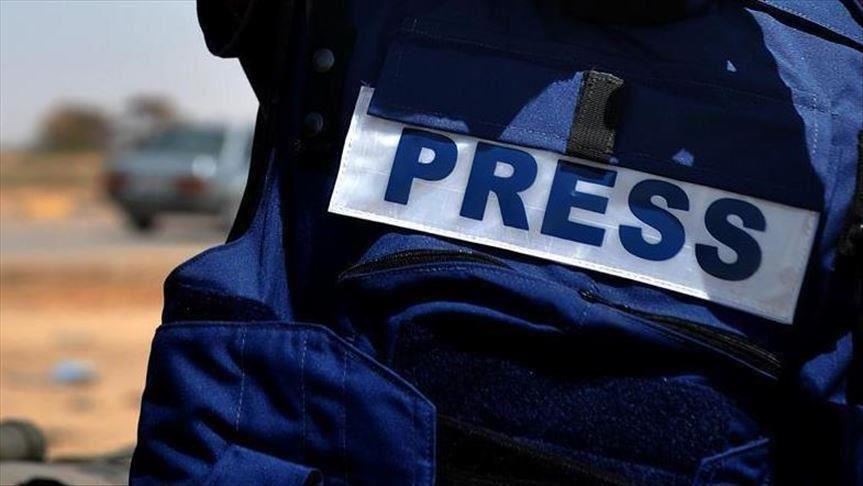
ANKARA
As conflicts continue to rage throughout the world, journalists are consistently exposed to danger and threats while carrying out their duties.
Turkish journalists spoke to Anadolu Agency about their experiences in hot spots over the years, recalling their struggles.
“I started journalism in the West Bank right from the heart of a conflict zone,” said Ediz Tiyansan, a correspondent at TRT World, Turkey’s first English-language news channel, adding he lived in Israel/Palestine for seven years, mostly in Ramallah, Jerusalem and Gaza.
For “7-8 years, I played with fire,” he said, recalling his experiences.
“Sometimes they [Israeli soldiers] directly employed [excessive amounts of tear gas] on people rather than using it to disperse the crowd. There would be risks of getting possibly shot or hit by tear gas or canisters in a sensitive area,” he said.
Another time, Israeli soldiers pointed a red laser dot on his cameraman.
“I saw a red laser dot on the forehead of my cameraman. I panicked, turned around with my hands up and yelled in Hebrew: ‘We are journalists! Do not shoot!’”
Citing this experience, Tiyansan highlighted the importance of knowing the language and culture of the local people in order to avoid further difficulties.
Psychological effect
Speaking about the difficult circumstances journalists are facing, Tiyansan also touched on the psychological impact it leaves on those witnessing conflicts.
“You spend days under constant Israeli airstrikes. It affects you psychologically. I remember missiles landing one after another right behind me about 200-300 meters away,” he added.
In 2014, Tiyansan said he also witnessed the killing of six civilians, which affected his mental health.
“When you are out there, seeing people die, it is difficult to keep calm.”
Libya
Tiyansan also went to Libya to cover the effects of the Arab Spring in the region.
Recalling his experience during his time there, he said he was on the front lines, where he witnessed bombardments and saw corpses.
He said in war zones, journalists are also exposed to danger as they are seen as representatives of the countries they are working for.
He said he experienced this in Libya as he had to remove TRT’s logo from his microphone.
Importance of training
Speaking about the protection of journalists in such regions, he highlighted problems such as accountability and liability.
Tiyansan said he underwent three types of training, including in first aid, which gave him the skills needed for working in critical areas.
“I was so close to fire and death,” he said, noting it is tremendously important to be aware of how to react in danger zones as a journalist.
10 killings in 2019
According to the Committee to Protect Journalists (CPJ), at least 10 journalists around the world have been killed so far this year. While five of the motives of these killings were confirmed, the other five remain unconfirmed, the organization said.
The CPJ is an independent nonprofit organization that has been promoting press freedom worldwide for more than 30 years with a board of prominent journalists that helps guide its activities.
It said every year, hundreds of journalists are attacked, imprisoned or killed, with 1,868 losing their lives between 1992 and 2019.
Emin Sansar, a photojournalist for Anadolu Agency, also emphasized the dangers of journalism.
“Hundreds of journalists have been killed since 2006. Journalists do not take sides in conflicts. They are neutral. Still, we become the targets,” he said, noting journalists began to lose their immunity especially after the Bosnian war started in 1992.
“No one, no group in a conflict environment cares about the press logo on your steel vest or your helmet. Everyone can be seen as enemies,” he said.
Recalling his time in Syria, Sansar said while covering Operation Euphrates Shield, he travelled with Free Syrian Army (FSA) commanders when their vehicle was ambushed.
The Turkish Armed Forces launched Operation Euphrates Shield on Aug. 24, 2016 to ensure border security and the return of Syrian refugees and prevent Daesh terrorism.
Sansar said they were stuck as they were exposed to crossfire.
“There was no place around to seek shelter -- only a stony area just 500 meters far behind us,” he said, adding he had to act quickly to save his life.
“I did the fastest run of my life. I heard the sounds of the bullets passing me very closely. These were moments of fear and thrill. I felt dizzy. I thought this was my end,” he said, noting he took a deep breath after reaching a shelter area.
Sansar said journalists, especially those working in critical areas, can be subjected to psychological and physical attacks.
“We are exposed to all kinds of violence. The basic principle of a journalist is to survive, obtain information and write news.”
Anadolu Agency website contains only a portion of the news stories offered to subscribers in the AA News Broadcasting System (HAS), and in summarized form. Please contact us for subscription options.







